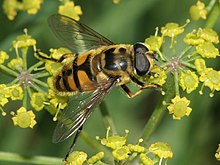| Myathropa florea | |
|---|---|

| |
| Male | |

| |
| Female | |
| Scientific classification | |
| Domain: | Eukaryota |
| Kingdom: | Animalia |
| Phylum: | Arthropoda |
| Class: | Insecta |
| Order: | Diptera |
| Family: | Syrphidae |
| Genus: | Myathropa |
| Species: | M. florea |
| Binomial name | |
| Myathropa florea (Linnaeus, 1758) | |
| Synonyms | |
Myathropa florea, sometimes referred to as the Batman hoverfly, is a very common European and North African species of hoverfly. Adults may be seen on flowers from May to September. It is of a similar size to the common drone fly (Eristalis tenax), but Myathropa are generally more yellow, with two light bands to the thorax, interrupted with a black central smudge. In museum specimens, any yellow colour soon fades to brown after death. Like most species in the tribe Eristalini, Myathropa are rather variable in size, shape and colour.
Description
For terms see Morphology of Diptera
The species has a wing length of 7–12 mm (0.3–0.5 in). Thorax dorsum with a characteristic "skull" black pattern. Abdomen black with yellow patterning. Legs pale and black. The larvae of the species were described and figured by Graham E. Rotheray in 1993.
See references for determination.
Distribution
Myathropa florea is found in the Palearctic from Fennoscandia south to Iberia and the Mediterranean basin, and from Ireland eastwards across Europe and Russia. It has been adventive on the Pacific coast of North America since 2005.
Biology
They occur in deciduous forests, fen carr, farmland with trees, parks, and gardens.
They visit many different species of flowers, including umbellifers, Castanea, Convolvulus, Crataegus, Chaerophyllum, Euonymus, Filipendula, Hedera, Rhododendron, Rubus, Sambucus, Solidago, Sorbus, and Viburnum opulus.
The flight period is May to October. Larvae feed on bacteria in organic waterlogged detritus, often in the shallow rot holes of tree stumps.
References
- Stubbs, Alan E. & Falk, Steven J. (1983). British Hoverflies: An Illustrated Identification Guide. British Entomological & Natural History Society. pp. 253, xvpp.
- "Batman Hoverfly". iNaturalist.
- "Batman Hoverfly – Myathropa florea". NatureSpot.
- "Batman Hoverfly". Gedling Conservation Trust.
- Rotheray, Graham E. (1993). "Colour Guide to Hoverfly Larvae (Diptera, Syrphidae)" (PDF). Dipterists' Forum. pp. 40–42. Archived from the original (PDF) on 13 January 2017.
- Van Veen, M. (2004) Hoverflies of Northwest Europe: identification keys to the Syrphidae. 256pp. KNNV Publishing, Utrecht.addendum
- Van der Goot,V.S. (1981) De zweefvliegen van Noordwest - Europa en Europees Rusland, in het bijzonder van de Benelux. KNNV, Uitgave no.32: 275pp. Amsterdam.
- Bei-Bienko, G.Y. & Steyskal, G.C. (1988) Keys to the Insects of the European Part of the USSR, Volume V: Diptera and Siphonaptera, Part I. Amerind Publishing Co., New Delhi. ISBN 81-205-0080-6.
- Coe, R.L. (1953) Diptera: Syrphidae. Handbks.ident.Br.insects, 10(1): 1–98. R.ent.Soc.London. pdf
- "Myathropa florea (Linnaeus, 1758)". Fauna Europaea. Retrieved 24 October 2019.
- Peck, L.V. (1988) Syrphidae. In: Soos, A. & Papp, L. (eds.) Catalogue of Palaearctic Diptera, 8: 11–230. Akad.Kiado, Budapest.
- BugGuide - Myathropa florea
- de Buck, N. (1990) Bloembezoek en bestuivingsecologie van Zweefvliegen (Diptera, Syrphidae) in het bijzonder voor België. Doc.Trav. IRSNB, no.60, 1–167.
- Speight, M.C.D. (2011). "Species accounts of European Syrphidae (Diptera)" (PDF). Syrph the Net, the Database of European Syrphidae. 65: 285pp.
| Taxon identifiers | |
|---|---|
| Myathropa florea | |